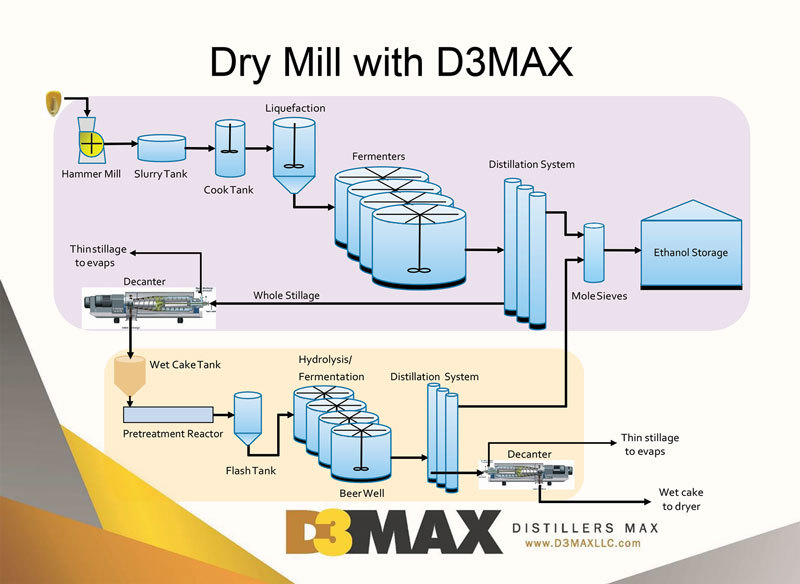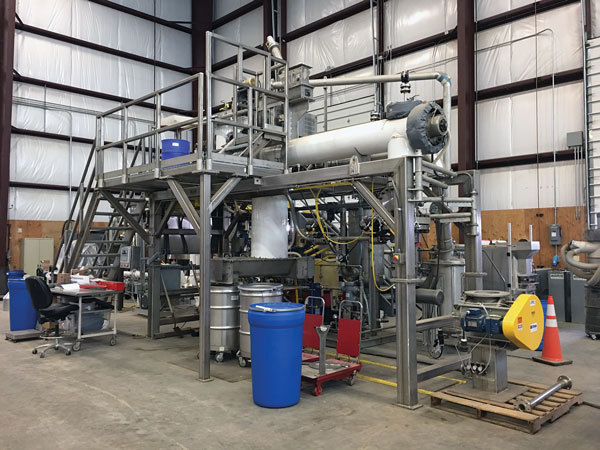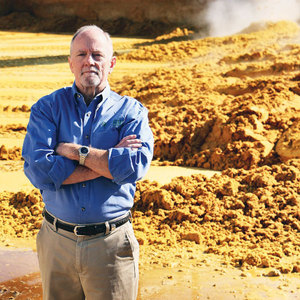Wet Cake Max-imization




PHOTO: MIKE BATEMAN PHOTOGRAPHY
October 14, 2016
BY Ann Bailey
D3Max, a company cofounded by BBI International, has developed a corn fiber-to-ethanol technology with the potential to increase the output of ethanol plants by 10 percent
The technology is groundbreaking due to its potential increase in profitability for ethanol plants, according to Mark Yancey, chief technology officer for D3Max. Twenty years in the making, the process is now poised to become a reality, Yancey says. Unique among the emerging cellulosic technologies, he says, it uses wet cake that has gone through the ethanol plant and has been cooked. “This allows us to run our pretreatment at much lower temperatures and avoid the plugging problems seen with some technologies.” Corn fiber contains only a small amount of lignin, so it is much easier to convert to fermentable sugars than cellulosic feed stocks such as corn stover, switchgrass and wood, he adds. Another advantage of the D3Max technology is that wet cake is available at ethanol plants and doesn't have to be grown, harvested, stored and transported the way other cellulosic feedstocks do.
Yancey believes the D3Max technology has great potential to be successful and make a huge impact on the ethanol industry. “If you look at the ethanol industry as a whole, all the corn fiber from dry mills would convert to 1.5 billion gallons of cellulosic ethanol—that’s the potential for this technology, just within the U.S.,” he says. “I think what is groundbreaking is the potential increase in the profitability of the ethanol plant. It’s much more significant than modifications to dry mills that are happening today. Producers do everything they can to maximize profitability, which is important, but there is no technology that will increase their bottom line as much as D3Max.”
2 Decades in the Making
D3Max’ corn-fiber-to-ethanol technology has its roots in research Yancey was involved in 1996 when he was a project manager at the National Renewable Energy Laboratory in Golden, Colorado. When making ethanol out of spent brewers grain, Yancey and the other researchers discovered that it was much easier to convert the distillers grain to fermentable sugars than to convert the other feedstocks being worked with. “In fact, NREL senior scientist Jim McMillan stated that spent brewers grain was the best feedstock that NREL had ever tested. That project was a success, but the market for converting spent brewers grain to ethanol is only about 70 million gallons a year, so the Department of Energy did not fund any further work, and that was kind of the end of that,” Yancey says.
Yancey revisited research into converting spent brewers grain into ethanol a decade later, in 2006, when Joe Coors Jr. asked him if he wanted to renew the 1996 project. By that time, Yancey had left NREL and was leading the project development team at BBI International. BBI gave the green light to the project and the BBI team designed a plant to convert the spent brewers grain at Coors brewery in Golden to ethanol. In 2008, when project developers were poised to begin raising money to build the plant, the bottom dropped out of the economy and the project was put on hold, Yancey says. He began working on the project again in 2010 and during the next several years obtained a patent for conversion of fermentation residual products to ethanol and made strides toward commercializing the technology. Last year, BBI formed D3Max LLC to commercialize the technology. Today D3Max is owned by Yancey, BBI and several private investors.
“For the past nine months, we’ve been raising money to finish the commercialization effort and we’re now designing a pilot plant to generate the data we need to design the commercial plant,” Yancey says.
The D3Max technology targets the corn fiber, composed of cellulose and hemicellulose, present in wet cake, using a three-step process. In the first pretreatment step, the wet cake is heated. “We add acid to reduce the pH and we hold it at that temperature and pH for five to 10 minutes. The result of that is some of the carbohydrates are broken down into fermentable sugars,” Yancey says. Specifically, the carbohydrates xylan and arabinan are converted to xylose and arabinose sugars, which can be fermented to ethanol. The pretreated wet cake slurry then goes through enzymatic hydrolysis in a large tank for 24 to 30 hours. “A mixture of enzymes is added that break down the cellulose to sugars, and then that material goes to fermentation where we add a genetically modified yeast to ferment all of the sugars to ethanol,” Yancey says. “The rest of the process is essentially the same as a dry mill. We go through a beer well, distillation column and then further purification of the ethanol to produce fuel ethanol.”
D3Max’s goal is to license its technology to at least 50 of the 200 dry mill ethanol plants in the United States and the dozen or so in Canada, Yancey says. All dry mill ethanol plants produce wet cake—wet distillers grains—that is typically dried and sold as animal feed. Converting the fiber and residual starch in wet cake would result in a 20 percent decrease in DDGS volume with a concentrated protein content of about 40 percent. Besides the 10 percent increase in ethanol production, the bolt-on technology brings a 0.5 pound-per-bushel increase in corn oil recovery.
The additional ethanol production would qualify as cellulosic, generating D3 renewable identification numbers—RINs that are used by obligated parties to demonstrate compliance with the renewable fuels standard. In early September, D3 RINs were trading at about $1.80 per gallon and corn ethanol was selling about $1.50 per gallon, so the potential revenue for cellulosic ethanol would be about $3.30 per gallon, Yancey says. “An advantage of D3Max is that RINs are directly measured from the ethanol produced, and not calculated as they are with some other technologies.” Furthermore, there are additional carbon credits available for fuel shipped to California under the state’s Low Carbon Fuel Standard.
Pilot Ahead
“We’re seeing huge demand for this product,” Yancey says. Three ethanol plants have expressed interest in hosting the pilot testing, with the final decision to be made yet this fall. Others have indicated they want to be the site of the first commercial plant, he says.
Design of the skid-mounted pilot is underway by Ohio-based AdvanceBio Systems LLC and construction will be finished by the end of the year, Yancey says. “The first of next year we will commission the pilot and begin testing. Data will be used to narrow the pretreatment time, temperature and pH,” Yancey says. Once the initial data is collected for the commercial-scale design, the pilot system can be trucked from plant to plant to demonstrate the D3Max technology.
AdvanceBio Systems modified its standard pretreatment reactor, which is made for high-solids biomass such as corn stover, for the D3Max pilot, which is a lower-solids feedstock, says Dale Monceaux, AdvanceBio Systems co-founder. The readily available wet cake definitely is an advantage for ethanol plants who will use D3Max technology, he says. “You’ve got stuff that is in a pile already. You don’t have to pay shipping costs. You don’t have to pay collection costs. It’s just the value of that material, as is, and it’s already been mechanically pretreated and it’s already been milled in the ethanol process, so there are a lot of benefits that allow for better economics.”
“If all goes as planned, the first D3Max plant will be under construction this time next year,” Yancey says.
Author: Ann Bailey
Associate Editor, Ethanol Producer Magazine
abailey@biinternational.com
701-738-4976
Advertisement
Advertisement
Related Stories
The USDA’s National Agricultural Statistics Service on June 30 released its annual Acreage report, estimating that 83.4 million acres of soybeans have been planted in the U.S. this year, down 4% when compared to 2024.
SAF Magazine and the Commercial Aviation Alternative Fuels Initiative announced the preliminary agenda for the North American SAF Conference and Expo, being held Sept. 22-24 at the Minneapolis Convention Center in Minneapolis, Minnesota.
Scientists at ORNL have developed a first-ever method of detecting ribonucleic acid, or RNA, inside plant cells using a technique that results in a visible fluorescent signal. The technology could help develop hardier bioenergy and food crops.
The 2025 International Fuel Ethanol Workshop & Expo, held in Omaha, Nebraska, concluded with record-breaking participation and industry engagement, reinforcing its role as the largest and most influential gathering in the global ethanol sector.
TotalEnergies and Quatra, the European market leader in the collection and recycling of used cooking oil, have signed a 15-year agreement beginning in 2026, for the supply of 60,000 tons a year of European used cooking oil.
Upcoming Events










